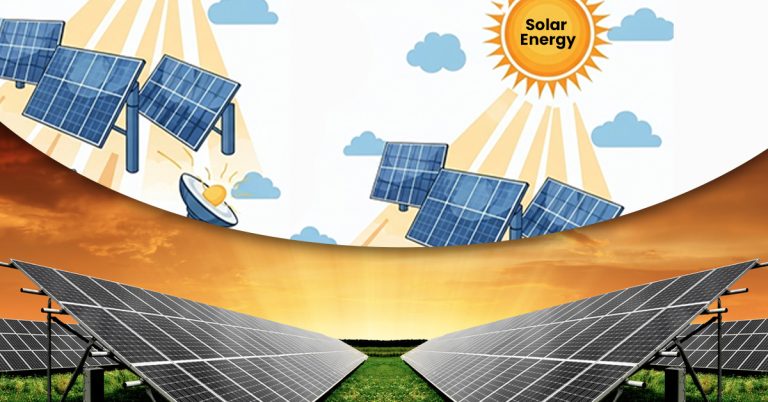20-Second Summary
If you are curious about what solar energy is? Then we have the answer.
Solar energy is the conversion of the energy from the sun into thermal and electric energy. This is not only a renewable source of energy but also helps you generate electricity for little to no bills, produces no noise pollution when generating energy, and is also sustainable and low-maintenance.
This blog post is going to explore solar energy and its types, along with the advantages, pros, cons, and its application in households and for businesses, because solar now provides 10% of global electricity in 2025
What is Solar Energy: Solar Energy Definition
Solar energy is a natural, renewable energy resource that converts the energy coming from the sun into thermal and electric energy.
This renewable energy offers noise-free energy production, lowers the consumption of water for energy production, and considerably decreases the electricity bills, being an environmentally friendly renewable resource.
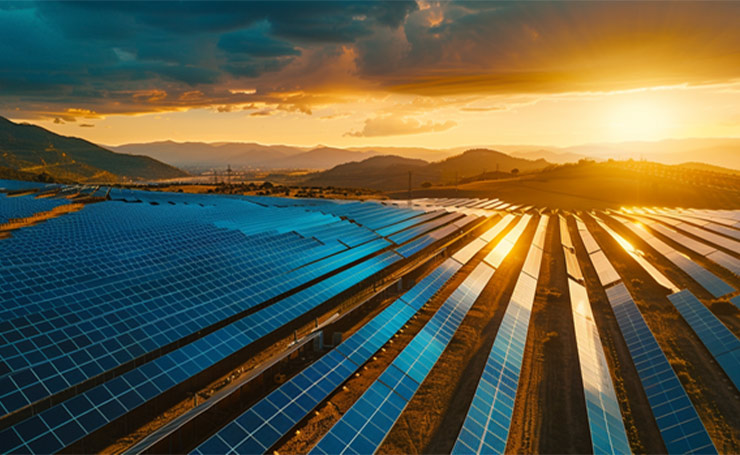
Talking about Solar Energy, let us have a look at some important stats from the year 2025:
- Global Solar energy installation capacity observed a surge of almost 64 percent more than in 2024, in the first half of 2025.
- The global CO2 emissions avoided due to solar energy were approximately 1.5 Gigatonnes.
- Today, the global solar capacity is almost over 1100 GW, and China is the country that has installed twice as many solar panels as the whole world.
- A typical solar system for a residence saves almost 3 to 4 tonnes of CO2, which is equal to planting almost a hundred trees.
- The global solar capacity is predicted to surpass 7.5 TW by the year 2035.
Looking at these statistics, we can see that solar energy is going to become a significant source of electric and thermal energy in the coming decades, with a potential for rapid expansion across global markets.
How Solar Energy Works
So how exactly does solar energy work? Let’s find that out!
Essentially, three technologies enable the conversion of solar energy into both thermal and electrical energy. Below, we provide a step-by-step explanation of how each technology converts solar energy into usable forms of thermal and electrical energy.
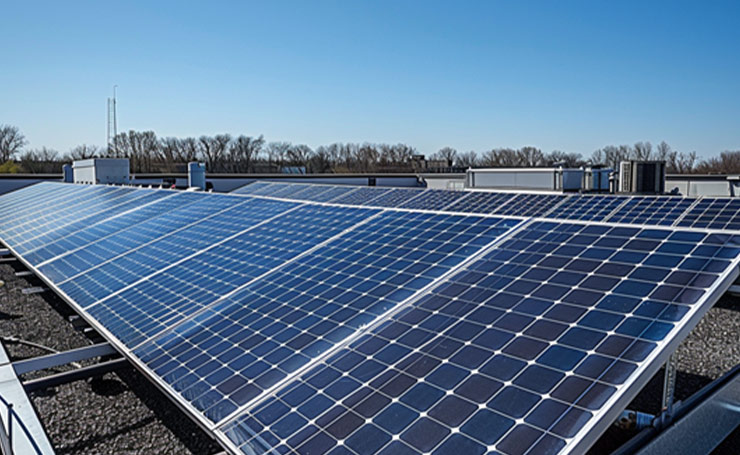
1. Photovoltaics (PV): Converting Sunlight into Electricity
Solar panels are known as Photovoltaic (PV) technology, and they are the common method used for generating solar power, which is being used worldwide.
- When sunlight hits a solar cell made of semiconductor material (usually silicon), photons knock electrons loose.
- This creates an electric current through the photovoltaic effect.
- This produces direct current (DC), which flows through wiring from multiple cells combined into solar panels and arrays.
- A solar inverter then converts the DC into alternating current, the form of electricity used in homes and businesses.
- The generated electricity powers appliances, charges solar batteries, or exports to the grid through net metering.
2. Solar Heating and Cooling (SHC): Using Solar for Thermal Energy
Solar heating and cooling systems directly capture the sun’s energy as heat.
- Solar collectors (flat-plate, evacuated tube, or air collectors) absorb sunlight and transfer it to a working fluid such as water or glycol.
- The heated fluid circulates into storage tanks or exchangers, providing hot water, space heating, or industrial heat.
- With the right setup, solar heat can also drive absorption or adsorption chillers to provide cooling in warmer climates.
These systems reduce fossil fuel use for heating and cooling, cutting both costs and emissions.
3. Concentrated Solar Power (CSP): High-Temperature Heat for Electricity
Concentrated Solar Power (CSP) systems use mirrors or lenses to concentrate sunlight onto a receiver.
- The receiver heats a transfer fluid, such as thermal oil, to extremely high temperatures.
- That heat produces steam, which drives a turbine connected to an electric generator.
- Concentrated Solar Power generates electricity from thermal energy, unlike PV, and often includes thermal storage tanks, which give a power supply even after sunset.
CSP is commonly used in large-scale commercial solar energy projects where dispatchable, grid-scale electricity is needed.
Main Types of Solar Energy
There are five main types of Solar Energy, and all of these have been explained below.
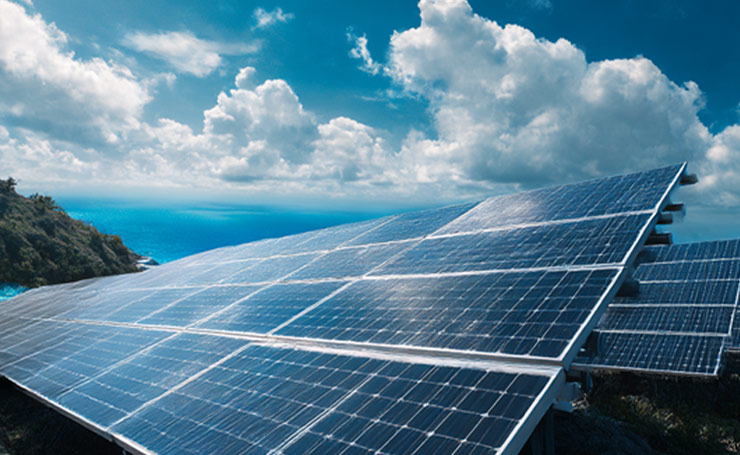
Photovoltaic (PV)
This is the most common type of energy that uses solar panel installation to produce electricity by using the photovoltaic modules that help to convert the radiation coming from the sun into electrical energy.
These solar panels are installed on the buildings where they can receive the most sunlight, and the energy produced can be converted into batteries for storage to be used at night, or can even be sent back to the power stations and then used directly.
Concentrated Solar Power (CSP)
The concentrated solar power (CSP) uses the energy from the solar radiation along with the use of thermal energy storage materials to generate the electric power that can be used when the sun is not available, making it possible to use the solar energy in the absence of the sun or during rainy or cloudy weather.
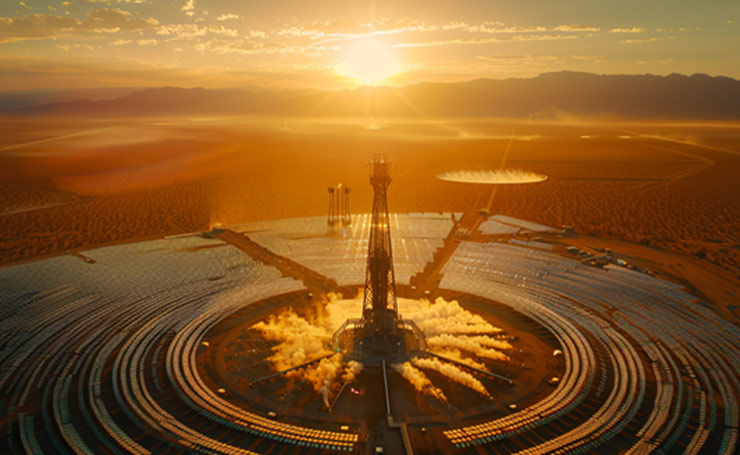
- The CSP basically uses optical devices, like mirrors or lenses, to reflect the light coming from the sun using a large area of mirrors on a smaller area that is the receiver of the energy.
- This receiving point converts this energy into high-temperature heat that is used to generate electricity after it gets collected by a working fluid (such as molten salt or thermal oil) that powers a steam turbine cycle to create electricity.
- The energy that a larger area of optical devices is being dropped on a single, smaller receiving area helps to create very high thermal efficiency, enabling CSP technology for mass production of electrical energy using the natural, renewable resource.
CSP is mainly deployed in large-scale commercial solar energy projects, making it a valuable contributor to the global renewable and clean energy supply.
Solar Thermal
Solar thermal energy is the type of solar energy that focuses on the production of heat and not electricity.
- It has solar energy collectors that capture the sunlight and convert it into heat using a working fluid like water or glycol that transfers this heat for direct use.
- The main applications of this energy are used in heating the water, space heating, Cooling using the solar chillers, and for industrial heat processes.
Passive Solar Energy
The passive solar energy utilizes the architecture of the buildings for harnessing energy from the sun.

- The system relies on smart building design (orientation, windows, insulation, thermal mass) to naturally absorb, store, and distribute solar heat and light.
- Basically, a passive solar energy system does not require any solar panels or mechanical systems for naturally heating your home, and uses two major components for the solar heating systems
- The glass (Windows) of your home should face south to get maximum sunlight for energy absorption.
- Thermal mass components like stone, bricks, or marble can absorb the energy and heat from sunlight and should be used within your infrastructure.
- With a proper orientation of your home’s passive solar system, you have the control to use the sun’s energy to heat up your home naturally.
Saying that necessarily does not mean that you can only heat up the building; passive cooling systems are also readily available that can block excessive heat using shading devices (awnings, overhangs), natural ventilation, reflective roofing materials, and landscaping (trees, pergolas) to cool down the temperature of your home without having to use an air conditioner.
Building-integrated Photovoltaics (BIPV)
The Building-integrated Photovoltaics helps to integrate the electricity generation directly into the building materials, with its main application in the rooftops, skylights, curtain walls, shading systems, and windows of modern buildings.
Basically, there are solar cells built into construction materials like roofs, facades, or windows, converting sunlight directly into electricity.
BIPV serves a dual purpose by acting as a functional part of the building’s structure while simultaneously generating clean energy.
The technologies that these systems use include:
- Crystalline silicon-based (c-Si) solar cells
- Thin film technologies such as:
- Amorphous-based silicon (a-Si)
- Cadmium telluride (CdTe)
- And copper indium gallium selenide (CIGS).
Solar Energy Components & Technology
The generation of solar energy depends on some important components and technologies that have been explained briefly below.

Solar Inverters
When the energy from the sun is collected by the solar panels, they generate electricity from this energy in the form of DC (direct current), which requires conversion into AC (alternating current), and a solar inverter basically converts the DC into the usable AC electricity that homes and businesses run on.
The different types of inverters include the string inverters, microinverters, hybrid inverters, and smart inverters that help to monitor the energy and also provide grid support.
Solar Batteries
We all know that solar energy is generated during the day using solar radiation, but how does it help us at night?

That is where the solar batteries become handy. They store the excessive electricity produced by the solar panels during the day so it can be used at night or during a power outage.
Some batteries used for storing solar energy include lithium-ion batteries (most efficient), lead-acid batteries (cost-effective), and flow batteries (long life).
Solar Storage
A solar storage system helps homeowners or businesses have the energy independence of not relying on the grid to store the excess energy produced by the solar system.
They use a solar system, a complete setup that combines the batteries with the control systems, inverters, energy management software, and sometimes backup integration.
Solar Installation
Solar installation is the technological process of setting up the solar energy system, from its design for the building orientation to its operations.
This includes site assessment, permits, mounting solar panels, wiring, inverter connection, and grid integration.
It is always recommended to get it installed professionally to ensure the safety and long-term efficiency with professional optimal positioning to get proper sunlight and maximum energy conversion.
Solar Energy Conversion Efficiency
Solar energy conversion efficiency determines how effectively each technology transforms sunlight into usable electricity or heat.
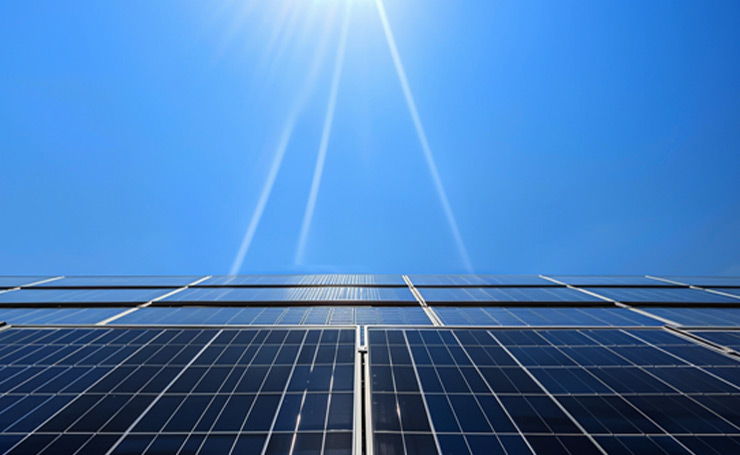
- A higher efficiency indicates there is more energy output coming from the same amount of sunlight.
- A good solar conversion efficiency helps to save costs, provides improved system performance, and has environmental benefits.
The table given below provides the average range of energy conversion by the major types of solar energy mentioned in our blog.
| Type of Solar Energy | Conversion Efficiency (Average Range) |
| Photovoltaic (PV) | 15% – 23% |
| Concentrated Solar Power (CSP) | 20% – 35% |
| Solar Thermal | 30% – 70% (for heating applications) |
| Passive Solar Energy | Not measured in % (design-dependent) |
| Building-Integrated Photovoltaics (BIPV) | 10% – 18% |
Solar Energy Applications
Solar energy application is seen both in residential areas and in commercial properties. Below, we have explained their application for both in a similar way, explaining how they impact both areas based on their scale.
Residential Solar Systems Applications
- Residential solar systems are typically small-scale, ranging from 3–10 kW, and are most commonly installed as rooftop photovoltaic (PV) setups
- These can be used for powering homes, appliances, lighting, heating, and EV charging.
- These can cut the bills from half to full percentage depending on the storage system size.
- Homeowners benefit from tax credits, rebates, and net metering programs that reduce upfront installation costs. They can earn credits for excess electricity sent to the grid, and these incentives make solar more affordable and speed up payback periods.
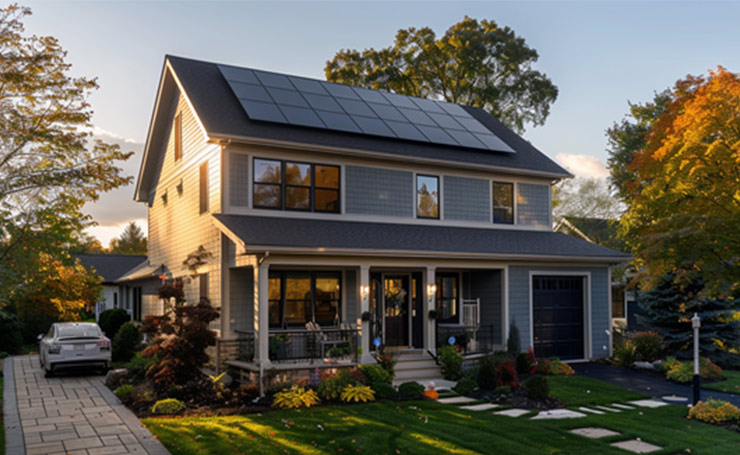
- Their payback period is 6 to 10 years on average.
- They require one or two batteries for the energy backup at night.
- They reduce 3 to 4 tonnes of CO2 annually for each home.
Commercial Solar Energy Applications
- Commercial solar energy systems are medium to large-scale, ranging from 100 kW to multi-MW systems.
- They can be used for powering office buildings, factories, schools, hospitals, and malls.
- Their installation can be rooftop, ground-mounted, solar farms, or integrated storage.
- These solar energy systems reduce the operational costs and also stabilize the long-term energy pricing.
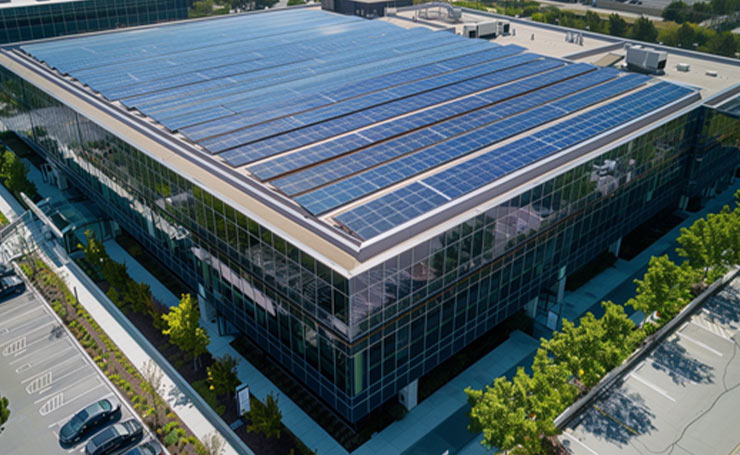
- These systems require larger battery banks or the installation of proper storage systems to manage the energy demand.
- Businesses can claim larger tax credits, accelerated depreciation, and renewable energy certificates in addition to rebates and net metering to cut costs and improve return on investment.
- The payback period is usually 4 to 8 years only because of their incentives and scale.
- The commercial solar energy systems are really great for a sustainable environment as they provide large-scale reductions by avoiding the production of thousands of tonnes of CO2.
Benefits of Solar Energy
The major benefits of solar energy have been given below:
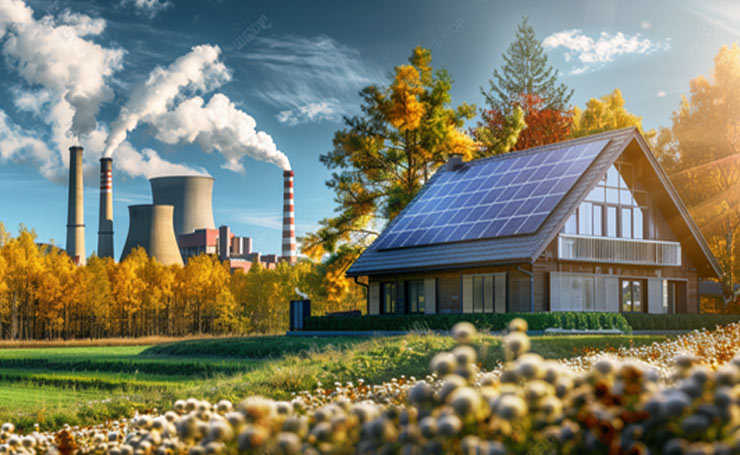
- By using a solar energy system, we can reduce carbon emissions because solar systems do not emit carbon or any other greenhouse gases.
- Solar energy is not going to end, meaning we can get an endless supply of heating and electricity using solar energy, making it the most beneficial.
- Using solar energy systems, homeowners can cut the cost of their billing to as much as a hundred percent by storing the energy to be used at night and investing in appliances that run on solar energy, like light bulbs, etc., for their garden and outdoors.
- If your solar system is generating excessive energy that is not used up by your home, then you can even get paid for the extra electricity generated by the solar energy that is being sent to the power grid from your home. So instead of paying for electricity, you get paid by the grid for the extra power they are getting from your system.
- The homes or buildings that have solar energy systems increase their resale value.
- The maintenance costs for solar systems are really low, as they only require cleaning to be able to keep performing. Investing in a solar panel can be wise due to the lower maintenance costs and a long lifespan that can be an average of 25 years.
- Even if you are in a state or region that is colder, the radiation coming from the sun is enough to provide the energy to your solar panels that can be stored and utilized. The amount of energy produced may be reduced, but the electricity production does not stop in the winter season either.
- If you use the batteries to store the solar energy, you can actually use them during the peak hours when electricity bills spike to reduce your costs on billing if you do not have the whole house running on a solar system.
- With a solar system applicable in any house or business, the fear of power outage is hardly present, making it possible to run major appliances like refrigerators and air conditioning.
- Those who live in a building without a suitable space, such as a rooftop or shading, for installing solar panels can utilise the community solar power system to their advantage.
Disadvantages of Solar Energy
When compared to the benefits, the disadvantages of the solar system are considerably less. A few have been given below:
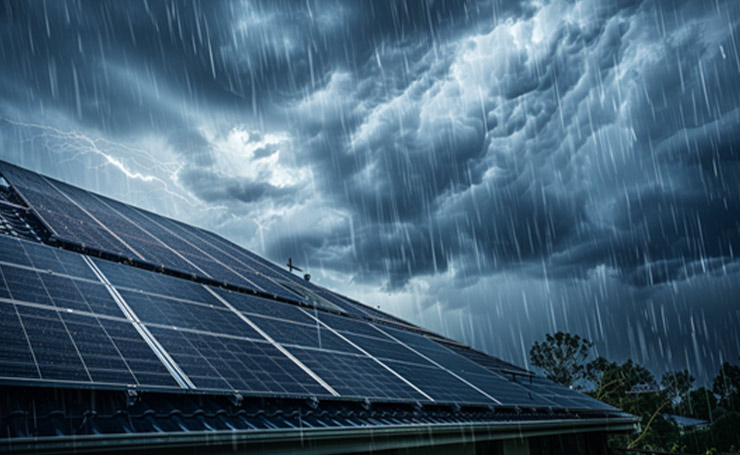
- Not every building is designed to be a fit for installation of the solar power systems, and in some place people do not have the community solar systems as well, making it a con of not being able to get the solar energy.
- The upfront cost of the installation of the solar energy system can also be counted as a disadvantage of the solar energy system, including extra costs to add batteries for more storage.
- Even though they can provide energy during a few cloudy days of winter, they are not capable of doing so during stormy weather, making them less ideal than other renewable energy resources like wind energy.
- In order to store the solar energy, we require storage batteries, and the production of these batteries could require the use of energy, leading to the emission of greenhouse gases and the destruction of habitat in order to mine the battery materials like lithium and silicon.
- Large-scale solar systems are once installed, fixed, and not portable, making it another disadvantage of solar energy.
- The recycling of the old material is still limited, making it another con of the solar energy systems.
Key Challenges and Future Trends
Let’s have a look at some key challenges and future trends for solar energy.

Key Challenges of Solar Energy
- High upfront installation and battery costs.
- Dependence on sunlight for energy production is low in rainy and stormy conditions.
- The recycling of old panels is limited.
- Limitations on the portability of large-scale installations.
- Inconsistent incentives, slow permits, and unclear grid rules can delay solar projects and discourage adoption.
Future Trends of Solar Energy
- Falling costs of solar panels and batteries will drive adoption, supported by advanced storage solutions.
- Smart grids, along with AI energy management, will prevail.
- Hybrid solar systems will exist using like using solar and wind energy systems together with storage.
- Portable solar systems will also start becoming available.
- There will be stronger global incentives and green policies.
Final Remarks: Role of Solar Energy in Renewable Energy Transition
Solar energy has played crucial role in the renewable energy transition by generating abundant, clean electrical and heating energy.

Other than this major role of energy transition, it has played a key role in:
- Significantly reducing greenhouse gas emissions.
- Offering diverse applications from large-scale farms to decentralised rooftop installations.
- Reducing the billing costs and increasing the payback costs by adding more value to their properties with installed solar energy systems.
- Supporting energy independence and economic growth.
Even though the world is already benefiting from this renewable energy resource abundantly, we have yet to see its large-scale global implementation making its impact bigger and our environment more sustainable.
For more informative blogs on renewable and green energy resources, keep coming back to Green Energy Insights, because we love giving updates on environmentally friendly energy solutions.
Frequently Asked Questions
Why is solar energy so beneficial?
Solar energy provides clean electricity, reduces bills and carbon emissions, increases property value and requires low maintenance.
What is the main function of solar energy?
It is to provide electrical energy and heating by decreasing the emission of greenhouse gases.
Can a house run 100% on solar?
Yes, a house can run 100% on a solar system with the installation of a solar system that can provide electricity to all appliances and store extra energy with batteries.
What are the five main types of solar energy?
Photovoltaic (PV), Concentrated Solar Power (CSP), Solar Thermal, Passive Solar Energy, and Building-Integrated Photovoltaics (BIPV).
What is the downside to going solar?
High upfront costs, weather dependence, limited efficiency in cloudy regions, and recycling challenges.
Can I run AC on a solar panel?
Yes, if you have a solar system that is sized correctly and has the capacity and storage to run an AC.
Is Solar Thermal Energy and CSP the same?
No, the Solar thermal captures sunlight directly as heat for water and space heating, but the CSP uses optical devices (mirrors) to concentrate sunlight for generating electricity.
Do Solar Panels Increase Your Property Taxes?
Yes, solar panels do increase the value of your property, but in some regions, they can exempt one from higher property taxes due to incentive policies.

